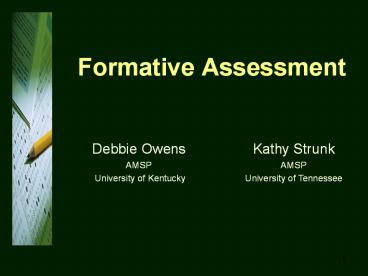Formative%20Assessment - PowerPoint PPT Presentation
Title:
Formative%20Assessment
Description:
University of Tennessee. Debbie Owens. AMSP. University of Kentucky. 2. Activity #1 - Brainstorm. Why do you assess your students? ... – PowerPoint PPT presentation
Number of Views:101
Avg rating:3.0/5.0
Title: Formative%20Assessment
1
Formative Assessment
Debbie Owens AMSP University of Kentucky Kathy Strunk AMSP University of Tennessee
2
Activity 1 - Brainstorm
- Why do you assess your students?
- How do you currently assess your students?
3
Session Target Goals
- Participants will
- articulate the differences between formative
- summative assessment
- recognize the impact of effective formative
- assessment
- describe and provide examples of how to
effectively - use the five keys to quality assessment
- use three guiding questions to ensure that
students - are informed and involved in the assessment
- process
4
Activity 2 - Card Sort
- Prepare a chart with two columns, label one
column Formative and the other column
Summative - Sort the cards and place each one under the most
appropriate heading in your chart
5
PART ONE
- Engage
- Explore
- Explain
6
Activity 3 - Magnets
- Work in groups of 4
- Three people are students and will complete the
activity. - One person (the teacher) is responsible for
assessing student learning.
7
Magnet Instructions
- Set up the materials as shown.
- Determine the relationship between the number of
weights and the number of magnets.
8
Teachers ????
- What do your students know?
- How did you find out what they know?
- Whats your evidence?
9
Students ????
- What did you learn?
- How do you know?
- What feedback would you like from the teacher?
10
- FIVE KEYS
- TO
- QUALITY
- ASSESSMENT
11
Why assess students?
- To gather evidence of student learning
- To inform instruction
- To motivate students and increase student
achievement
12
- Identify the Purpose
- Who will use it?
- How will it be used?
13
What do I want them to know?
STANDARDS
UNIT GOALS
TARGETS
14
- Clarify the Targets
- Deconstruct standards
- Are they clear to the students?
15
(No Transcript)
16
PART TWO
- Elaborate / Extend
- Evaluate
17
Demonstration
18
Three Guiding Questions
- 1
- Where am I going?
19
- FIVE KEYS
- TO
- QUALITY
- ASSESSMENT
20
The Five Keys So Far
- Identify the Purpose
- Clarify the Target
21
How Will I Know When They Know It?
- What method should I choose?
- Is it written well?
- Is the sample size appropriate?
- Are there sources of bias in it?
22
- Use Sound Design
- Method?
- Sample?
- Quality?
- Bias?
23
Activity 4 - Temperature
- Discuss Activity
- Clarify Targets
- Prediction
- Demonstration
- Feedback
- Corrections
24
- Provide Effective Feedback
- The best feedback is
- Descriptive
- Specific
- Relevant
- Timely
- Empowering
25
Three Guiding Questions
- 2 - Where am I now?
- 3 - How do I close the gap?
26
Activity 5 - Floating
- Prediction
- Demonstration
- Clarify Purpose and Targets
- Partner Exploration
- Feedback
27
Think/Pair/Share
- How effective were you at giving feedback?
- What could you do differently to make it more
effective?
28
Involve Students
- Peer Assessment
- Self-assessment
29
??? to ask before assessing
- Why am I assessing?
- What do I want my students to know?
- How will I find out if they know it?
- How will I communicate the results of my
assessment? - Who should be involved?
30
In Other Words
- Clarify your purpose.
- Define your target goals.
- Design your plan - what tool(s) will I use to
determine if students have met the goals? - Provide feedback to encourage learning (Do No
Harm!) - Involve students in their own assessment.
31
The 5 Keys and the Guiding Questions
Identify the Purpose
Clarify the Targets
Use a Sound Design
Provide Effective Feedback
Involve Students
Where am I going?
Where am I now? How do I get there?
32
Shifts in Assessment
To assessing to learn what students
understand To using results to inform
instruction To students engaged in ongoing
assessment of their work and others To
descriptive feedback that empowers and motivates
students
From assessing to learn what students do not
know From using results to calculate
grades From end-of-term assessments by
teachers From judgmental feedback that may harm
student motivation
33
Why these shifts in assessment?
- A change in the mission of schools
- A shift from a focus on sorting and ranking
- students to a focus on leaving no child behind.
- A strong research base
- Evidence of the substantial impact on student
achievement
34
- Change focus from what you put into it, to what
students get out of it. - Dylan Wiliam
- Formative Assessment evolves through continual
action research it is not another initiative. - Shirley Clarke
35
SELF-EVALUATION
- Follow the directions on the handout Determining
Where I am Now - Record your Ratings for 1-9 on the separate
answer sheet - Wait for directions from a facilitator
36
Professional Development Basics
- Change begins with disequilibrium.
- Teacher networks can be powerful.
- Teachers need proof that it works in the
classroom. - Understanding deepens when the teacher
experiences it in a real context. - Innovation is risky.
- Schools that promote effective professional
development also encourage experimentation. - Change without reflection is often shallow and
incompetent. - Adapted from Classroom Assessment and the
National Science Education Standards































